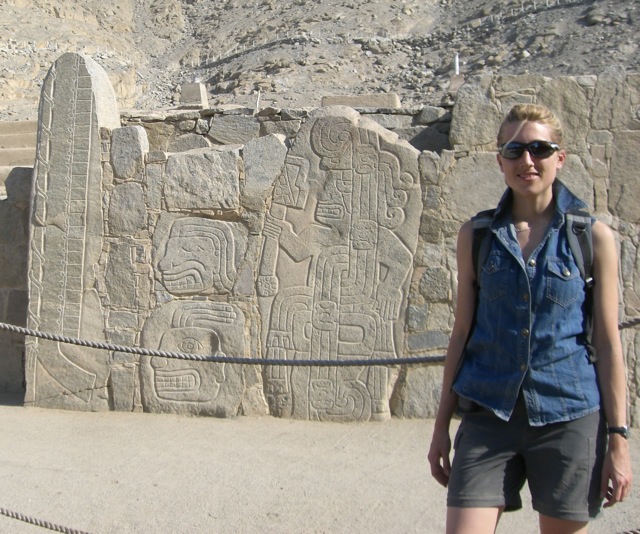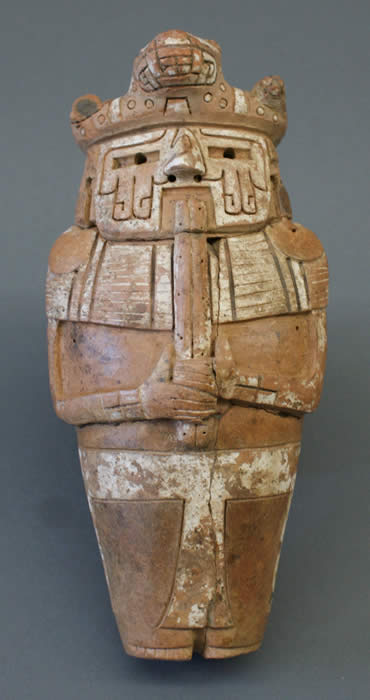Julia Zumstein
Research Student
Education
2006 - BA(hons) / MA Cantab in Archaeology & Anthropology. University of Cambridge, UK.
2010 - MA in the Arts of Africa, Oceania & the Americas. SRU, University of East Anglia, UK.
PhD Thesis
“Cupisnique, Tembladera, Chongoyape, Chavín ? The Ceramic Styles of Formative Period North Peru.”
Project Introduction – The Problem
During the 1960s and 70s, the illegal destruction of archaeological sites along the north coast of Peru brought a great number of artefacts of an impressive quality and high artistic and technological skill to light. This is true for most Initial Period and Early Horizon sites in the valleys of Moche, Chicama, Jequetepeque, Zaña and Lambayeque on the north coast. Materials were quickly dispersed to private and public collections around the world. The scarcity of systematic archaeological investigations in this area make it extremely difficult to position these objects in their correct archaeological frame and cultural context. Nonetheless, stylistic and iconographic similarities are notable and suggest contemporaneity and interaction.
Historically, (especially due to Julio C. Tello’s important contributions to the scholarship of Peruvian archaeology) Chavín de Huantar was considered a kind of “mother culture”; the source of all sophisticated material culture and iconography in early northern Peru. As such, many of these northern ceramics were considered variants of Chavín itself, and thus labelled as such. Conversely, many ceramics were assigned labels based on their reported site of provenance, leading to terms such as ‘Cupisnique’, ‘Tembladera’, ‘Chongoyape’ and ‘Zaña’, none of which have ever been properly defined. (Donnan 1992 includes a rudimentary summary, but it remains basic and flawed.)
Museum curators and scholars worldwide continue to struggle with these cultural and/or stylistic labels. Some institutions have resolved to label anything that is considered Formative Period North Coast simply as ‘Cupisnique’ (for example, the Museo Larco and the MALI), leading to a further obscuring of the artistic (and cultural?) diversity in this time period.
This is augmented by the fact that our understanding of the chronology of early North Peru remains fragmentary. The Formative was a period of enormous cultural change. Spanning more than 1500 years (consensus roughly at 1800 – 200 BC) it seems imprecise to consider all ceramics from this period as belonging to just one stylistic and/or cultural category, whatever that may be called. It is high time that stylistic types were more specifically defined and, where appropriate, cultural designations and timeframes assigned.
PhD Project - Methods
My PhD thesis is based on the analysis of some 400 ceramic pieces located in museum collections around the world, as well as published pieces. It includes primarily vessels and modelled figurines.
I have compiled a database of all examined pieces, recording a variety of formal characteristics, both technological and iconographic. To process this data, I am experimenting with statistical analyses (using SPSS). The primary aim is to reveal ceramic groupings based on commonality of features. Secondary outputs from this calculation may further reveal which characteristics are statistically significant in defining groupings (in the northern Andes e.g. for the Moche culture, spout-shape has widely been considered as the defining chronological characteristic, and I hope to test assumptions such as these for my data).
It is hoped that the results of my analysis will make it more definitively possible to discuss types of ceramics and relate them to previously published stylistic or cultural labels, or indeed postulate the existence of new, previously unrecognised sub-styles. As far as possible, these groupings will be linked to published data, but also to my experience of an observations from archaeological excavations, to determine whether patterns of provenance and / or time period can be discerned for certain stylistic types. For instance, one particular aim is to ascertain whether the so-called “Tembladera Figurines” can be conclusively related to an identified ceramic style, and hence their chronological and cultural associations more clearly established.
The identification of sub-style groupings will oblige me to consider one of the fundamental questions in archaeology: whether stylistic/material entities translate into social realities, be they ethnic, hierarchical, chronological or otherwise. In making an argument for cultural or ideological difference, it is imperative to consider contextual data such as architecture and burial practices.
Figurative Iconography & Human Representation
However, given the florescence of figurative ceramics in this region at this time, in contrast to the rarity of excavated archaeological contexts, it is suggested that figurative ceramics offer a key avenue for the study of Jequetepeque valley communities and identities in the Formative Period. Iconography and archaeology are tightly interwoven as a method for studying identity/persons in Andean archaeology, not least because of finds where the archaeological context precisely mirrors that depicted in the figurative material culture (esp. Moche culture). Furthermore, the Formative period encompasses not only great social change, but also the first depictions of humans in material culture. As such, one section of this study will focus on the nature and imagery of human depictions from the Formative Period Jequetepeque valley, in order to discuss how ancient Andeans conceived of themselves and social others.
Further Interests
The Chavín phenomenon; the development of complex society and the sources power; archaeology of ritual, religion, shamanism; the role of music in Formative Period Peru; expressions of identity and personhood; anthropomorphism and the origins of figurative representation.

Julia Zumstein

Tembladera Figurine, Museum zu Allerheiligen Schaffhausen. Photo © J.Zumstein

Museum zu Allerheiligen, Schaffhausen. Photo © J.Zumstein.

Museum zu Allerheiligen, Schaffhausen. Photo © J.Zumstein.

